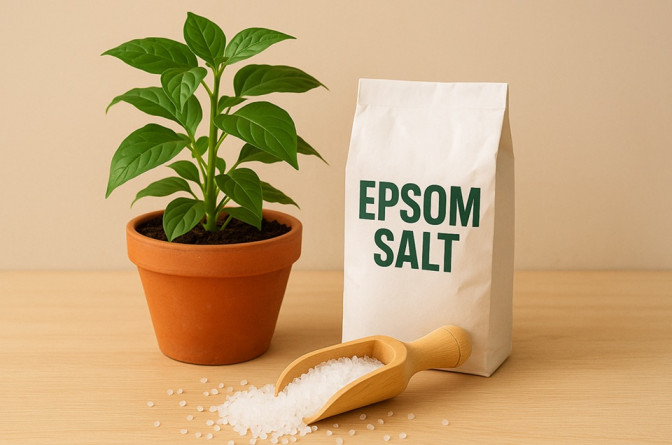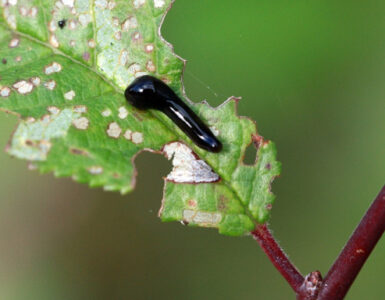Have you heard the buzz about Epsom salt? It’s said to help certain plants grow bigger, stronger, and more beautiful.
But what is it, and how does it work? In this article, we’ll explore the wonders of Epsom salt and how it can help your plants reach their full potential.
This guide covers Epsom for gardening. You’ll learn what it is, how to use it, and how it helps your garden and plants.
1. Improve Seed Germination
The magnesium in Epsom salt helps seeds create stronger cell walls. This leads to sturdier and more resilient seedlings.
Adding Epsom salt to the soil of plants that are magnesium-deficient will also help them grow stronger.
Dissolve one tablespoon of Epsom salt in a gallon of water. Apply it as a soil drench before you begin planting seeds.
2. Brighten Up Foliage
You can tell when a plant isn’t getting enough magnesium by the yellowing between the leaf veins. There may also be an early fall of leaves.
Magnesium is needed for plants to produce chlorophyll. Chlorophyll is what gives leaves their bright, healthy green color.
When your plants are looking less than perky, give them some Epsom salt to help brighten them up.
So, how much should you use? The dosage is two tablespoons per gallon of water.
Use the solution to water the soil around the plants. Do this once every month.
The dosage is the same for potted plants.
3. Prevent Transplant Shock
It is always risky to move seedlings from a container to the ground or to repot a grown plant.
Often, a plant undergoes various stresses when transplanted. This is known as transplant shock [1]. As a result, if not properly cared for, the affected plant may never recover.
Use Epsom salt to help combat the risks of transplant shock and encourage nutrient absorption. After transplanting, water the affected plants with a mixture of one tablespoon of Epsom salt and a gallon of water.
4. Keep Away Pests
Epsom salt works wonders for preventing many undesirable garden pests.
Although it won’t kill snails and slugs like table salt does, it will irritate them enough to keep them away from your plants. Therefore, sprinkle some Epsom salt around the base of your outdoor and indoor plants.
This home remedy works like diatomaceous earth. It scratches and irritates the soft bodies of these slimy pests.
5. Increase the Productivity of Fruit Trees
Applying Epsom salt to the roots of fruit trees can help boost the trees, resulting in a larger yield and sweeter fruit.
Dissolve two tablespoons of Epsom salt in a gallon of water. Next, pour this DIY solution around the base of each tree once a month.
6. Sweeter Tomatoes
Epsom salt is beneficial for your tomato plants because it helps make the fruits taste sweeter. Some home gardeners consider it an excellent tomato fertilizer.
To use Epsom salt on tomato plants, the dosage is two tablespoons per gallon of water. Let it dissolve before applying it around the base of your plants.
Repeat this every two weeks.
7. Strengthen Pepper Plants
Like tomatoes, pepper plants can also become magnesium-deficient.
However, Epsom salt can help give pepper plants the needed boost in magnesium. This will result in a bigger yield.
To use Epsom salt on pepper plants, dissolve two tablespoons of Epsom salt in a gallon of water. Shake well and spray on the leaves of the plants.
8. Boost Cucumbers
Epsom salt can also provide cucumbers with a boost of energy, helping them produce more fruit. However, please do not rely on it as your sole source of fertilizer.
To use Epsom salt on cucumbers, mix one tablespoon of Epsom salt in a gallon of water and pour it around the base of the plant, near the roots. Do this every two weeks.
You can also apply it as a foliar spray.
9. Healthier Roses
Are your roses looking dull and lacking vigorous blooms? The missing ingredient is likely magnesium.
It is believed by many that magnesium increases the number of blossoms that a rose plant yields. Magnesium also helps to increase the production of chlorophyll in these plants.
Adding some Epsom salt to the soil when first planting your rose bushes will result in gorgeous roses.
You can also apply it to existing rose bushes by sprinkling half a cup of Epsom salts around the base of the plants and watering well. It’s best to do this before the plants start to bloom.
10. Keep Your Lawn Green
Although some people do not consider their lawns part of their garden, they are still something many of us want to keep healthy and green.
Use Epsom salt on your lawn to enhance nutrient absorption and growth. While it’s not a complete fertilizer for grass, you can still use it to improve the look of your lawn.
Apply it with a spreader (about 2.5 pounds per 1,000 square feet). Alternatively, dilute it in water and spray the desired area.
Epsom salt also serves as a pest deterrent, keeping away raccoons, slugs, and other pests from your lawn.
11. Homemade Weed Killer
Does Epsom salt kill weeds? Yes, highly concentrated amounts can, and it works even better when combined with other ingredients, such as vinegar.
Create a homemade Epsom salt weed killer by combining ½ cup of liquid dish soap, 2 cups of Epsom salt, and 1 gallon of household white vinegar.
This 3-ingredient weed killer is an easy way to cut costs on store-bought herbicides. It will also eliminate the need to pay someone to weed your garden manually.
Plants That Like Epsom Salt
You can use Epsom salt on nearly all garden plants. But the ones that benefit the most are those highlighted above.
Nonetheless, Epsom salt is mainly used on tomatoes, peppers, and roses. However, please do not use it as a substitute for fertilizer, as its N-P-K value is 0-0-0 [2].
Where to Buy?
You can get Epsom salt at most pharmacies, supermarkets, or online at reputable gardening stores such as DoMyOwn or SeedsNow.
Takeaway
As you can see, there are many uses for Epsom salts in the garden. It is a handy product that all gardeners should appreciate.
Its wide range of benefits, from increased crop yield to pest control, puts it on the list of natural and effective gardening remedies.








Add comment